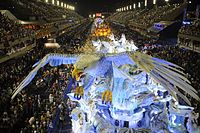
Human-induced changes in the trophic functioning of sandy beaches
Sign Up to like & getrecommendations! Published in 2017 at "Ecological Indicators"
DOI: 10.1016/j.ecolind.2017.07.016
Abstract: Abstract The increasing anthropogenic disturbance on coastal ecosystems has threatened ecological interactions and ecosystems functioning. To investigate if human pressure affects the trophic structure of sandy beaches, mass-balanced models were applied on two Brazilian sandy… read more here.
Keywords: changes trophic; induced changes; human induced; functioning sandy ... See more keywords

Comparisons of microplastic pollution between mudflats and sandy beaches in Hong Kong.
Sign Up to like & getrecommendations! Published in 2018 at "Environmental pollution"
DOI: 10.1016/j.envpol.2018.01.031
Abstract: Most of the previous studies of microplastic pollution on coastal habitats focused on high energy beaches although low energy areas such as mudflats are supposed to retain more microplastics, not to mention that mudflats are… read more here.
Keywords: mudflats sandy; pollution; hong kong; beaches hong ... See more keywords

Longshore propagation erosion of beach in the vicinity of tsunami-induced concave shoreline
Sign Up to like & getrecommendations! Published in 2019 at "Journal of Hydro-environment Research"
DOI: 10.1016/j.jher.2019.01.003
Abstract: Abstract The 2011 Great East Japan Earthquake and Tsunami caused significant changes in the morphology of the Sendai Coast, Miyagi Prefecture, Japan. These tsunami waves and the return flows resulted in the formation of concave… read more here.
Keywords: propagation; tsunami; erosion; sandy beaches ... See more keywords

The dynamics of plastic pellets on sandy beaches: A new methodological approach.
Sign Up to like & getrecommendations! Published in 2020 at "Marine environmental research"
DOI: 10.1016/j.marenvres.2020.105219
Abstract: Plastic found in the coastal zone is a result of waste mismanagement. This material comes directly from offshore disposal or by fishing debris, other marine activities, and by marine currents and winds, as well as… read more here.
Keywords: beach; beaches new; pellets sandy; plastic pellets ... See more keywords

Evaluation of environmental quality of sandy beaches in southeastern Brazil.
Sign Up to like & getrecommendations! Published in 2017 at "Marine pollution bulletin"
DOI: 10.1016/j.marpolbul.2017.04.045
Abstract: The effect of urbanization on the environmental quality of two sandy beaches was evaluated using metrics such as pH, dissolved oxygen, coliforms and solid waste. Urbanization effects on physicochemical metrics (pH and dissolved oxygen) were… read more here.
Keywords: environmental quality; quality sandy; evaluation environmental; sandy beaches ... See more keywords

Microplastic contamination of sandy beaches of national parks, protected and recreational areas in southern parts of the Baltic Sea.
Sign Up to like & getrecommendations! Published in 2021 at "Marine pollution bulletin"
DOI: 10.1016/j.marpolbul.2021.113002
Abstract: The distribution of small (0.5-2 mm, S-MPs) and large (2-5 mm, L-MPs) microplastics and mesoplastic particles in 51 samples of surface beach sands at 7 locations along the southern shore of the Baltic Sea was investigated. MPs… read more here.
Keywords: microplastic contamination; baltic sea; contamination; contamination sandy ... See more keywords

Sandy coastlines under threat of erosion
Sign Up to like & getrecommendations! Published in 2020 at "Nature Climate Change"
DOI: 10.1038/s41558-020-0697-0
Abstract: Sandy beaches occupy more than one-third of the global coastline 1 and have high socioeconomic value related to recreation, tourism and ecosystem services 2 . Beaches are the interface between land and ocean, providing coastal… read more here.
Keywords: sea level; level rise; change; climate change ... See more keywords

Tourism impacts on benthic communities of sandy beaches
Sign Up to like & getrecommendations! Published in 2017 at "Marine Ecology"
DOI: 10.1111/maec.12440
Abstract: This study evaluated the effect of human trampling on the benthic macrofauna of two beaches in Southeast Brazil with different levels of intensity of tourism, Grussai (more impacted) and Manguinhos (less impacted), during periods of… read more here.
Keywords: tourism; impacts benthic; tourism impacts; communities sandy ... See more keywords

Microbial communities in sandy beaches from the three domains of life differ by microhabitat and intertidal location
Sign Up to like & getrecommendations! Published in 2022 at "Molecular Ecology"
DOI: 10.1111/mec.16453
Abstract: The microbial communities of sandy beaches are poorly described despite the biogeochemical importance and ubiquity of these ecosystems. Using metabarcoding of the 16S and 18S rRNA genes, we investigated the diversity, microhabitats (with or between… read more here.
Keywords: communities sandy; ecology; beaches three; microhabitat intertidal ... See more keywords

Fauna of Free-Living Nematodes (Nematoda) of Sandy Beaches of Lake Baikal Splash Zone in Intense and Moderate Anthropogenic Influence Areas
Sign Up to like & getrecommendations! Published in 2019 at "Inland Water Biology"
DOI: 10.1134/s1995082919040096
Abstract: The qualitative and quantitative characteristics of the fauna of free-living nematodes in the splash zone of sandy beaches in two regions of southern Baikal (Listvenichny Bay, opposite Nerpinariy, and Bolshie Koty Bay in the Varnachka… read more here.
Keywords: splash zone; free living; zone; sandy beaches ... See more keywords

HUMAN TRAMPLING EFFECT ON BENTHIC FAUNA OF SANDY BEACHES WITH DIFFERENT INTENSITIES OF USE IN RIO DE JANEIRO, BRAZIL
Sign Up to like & getrecommendations! Published in 2019 at "Oecologia Australis"
DOI: 10.4257/oeco.2019.2301.03
Abstract: About 75% of the world’s shoreline is composed of beach environments. Among them, the sandy beach is a familiar environment and used for tourism and recreation. The organisms that live in these environments, as polychaetes,… read more here.
Keywords: different intensities; intensities use; rio janeiro; sandy beaches ... See more keywords